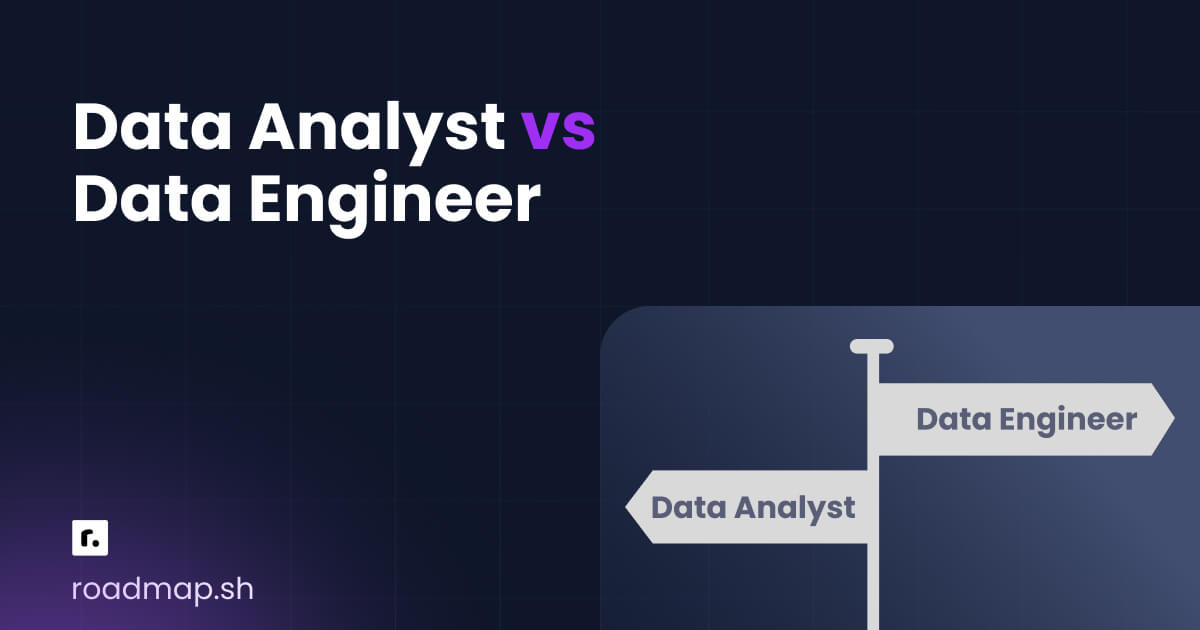Other Guides
In this article
Data Analyst vs. Data Engineer: Skills, Salary, and more

If you're considering a career in data, you've likely come across two common but often confusing roles: data analyst and data engineer. Both play a critical role when it comes to getting insights from data, but they differ in required skills, focus, earning potential, and career path. Analysts turn data into business insights, while engineers build the infrastructure that makes that possible.
TL;DR
Focus:
Data Analyst: Business insights, reporting, data storytelling.
Data Engineer: Data pipelines, architecture, infrastructure.
Skills:
Analyst: SQL, Excel, data visualization, basic Python/R.
Engineer: Python/Scala, SQL, ETL tools, cloud platforms.
Output:
Analyst: Dashboards, reports, insights.
Engineer: Data warehouses, pipelines, clean datasets.
Earning Potential:
Engineers generally earn more due to higher technical complexity.
Best Fit For:
Analyst: You like interpreting data and influencing decisions.
Engineer: You enjoy building systems and working with code.
Data analyst vs. data engineer
The table below highlights the major differences between data analysis and data engineering to help you evaluate which one might be the right fit for you:
Category | Data Analyst | Data Engineer |
|---|---|---|
Focus | Interpreting data to answer business questions | Building and maintaining data infrastructure |
Typical output | Dashboards, reports, visualizations | ETL pipelines, data warehouses, streaming systems |
Key tools | Excel, SQL, Python (pandas), Tableau, Power BI | Python, SQL, Airflow, Spark, Snowflake, dbt, Kafka |
Collaboration | Works closely with business stakeholders, product managers | Works with data teams, software engineers, DevOps |
Career path | Junior Analyst → Senior Analyst → Analytics Lead → Strategy Roles | Junior Engineer → Senior Engineer → Data Architect → ML Engineer or Platform Lead |
Coding required? | Moderate (SQL, Python for analysis) | High (Python, Scala, Java, infrastructure scripting) |
Work style | Cross-functional, presentation-heavy | Technical, system-focused |
Salary range (US) | $75K–110K | $95K–135K |
Before looking at these aspects in detail, let's take a closer look at these two fields.
What is data analysis?
Data analysis is the process of examining, cleaning, transforming, and modeling data to uncover useful insights, draw conclusions, and support smarter decision-making. It's all about making sense of raw information using a mix of statistical analysis and logical techniques.
In practice, data analysis generally falls into four main categories:
Descriptive analysis: This type of analysis looks at historical data to figure out "what happened." Think of it as a snapshot of past events. For example, if you're running an e-commerce store, descriptive analysis might help you find the average number of sales per product last month. It's about getting a clear summary of the past.
Diagnostic analysis: In this type of analysis, you're digging deeper to understand "why something happened." Let's say a product that was selling well suddenly dropped in sales last quarter; a diagnostic analysis would involve examining other business data, like customer reviews, marketing spend, or competitor pricing, to find possible causes.
Predictive analysis: This is all about forecasting based on past data and asking questions like "what's likely to happen next?" For example, if you notice that people tend to buy workout gear more often in January, predictive analysis can help you prepare your inventory for that trend.
Prescriptive analysis: This goes a step further by asking: "What should we do about it?" For instance, if a product consistently sells out within days, prescriptive analysis might recommend increasing inventory or adjusting the supply chain to meet demand more efficiently.

Regardless of the type of data analysis you conduct, most data analysis processes follow a similar approach. Here's a typical flow:
Collecting data: This step involves gathering information from various sources, such as surveys, sensors, database systems, and web analytics, and then consolidating it into a single location, such as a spreadsheet, data warehouse, or cloud platform. The key is to make the data accessible and ready for the next steps.
Cleaning data: Raw data is rarely perfect. It often comes with missing values, duplicates, errors, or inconsistencies. Cleaning helps you fix these issues so that the analysis doesn't produce misleading results. For example, imagine one record says "New York" while another says "new yorK"; they should clearly mean the same thing, but a computer won't always treat them that way.
Exploratory data analysis (EDA): At this stage, you're trying to understand the structure of the data. What are the trends? Are there any outliers? What relationships exist between variables? You might create charts, calculate averages, or explore distributions to start forming hypotheses. For instance, you could visualize customer age vs. average spending to identify patterns.
Modeling data: This is where you apply statistical methods or machine learning algorithms. The goal could be to test a theory, measure uncertainty, or predict future outcomes. For example, a retailer might use regression analysis to understand how pricing affects demand.
Interpretation and communication: The final step is making the findings clear and actionable, especially for stakeholders who may not have a technical background. This often involves creating data visualization dashboards, writing reports, or giving presentations that turn raw numbers into meaningful stories. At the end of the day, the purpose of data analysis is to help people make informed decisions.
What is data engineering?
Data engineering is all about building the backbone that makes data usable. It involves designing, developing, and maintaining the systems that enable organizations to collect, store, and process data. These systems support everything from analytics and reporting to machine learning and other data-driven applications.
While a data analyst's primary role focuses on what the data means, data engineers ensure that the data is received in the right format, at the right time, and in the right place. Think of it like setting up the pipes and water tanks before anyone can start filling cups.

The following is a breakdown of what data engineering typically involves:
Data collection and ingestion: This step involves integrating data from various sources, including databases, APIs, IoT sensors, web scraping tools, and real-time event streams, among others. A good ingestion pipeline handles various data formats and keeps data flowing reliably.
Data storage and architecture: Once data is collected, it needs a place to live. This involves setting up storage systems like data lakes or data warehouses. The goal here is to store large volumes of data in a way that's organized, efficient, and accessible for future use.
Data processing and transformation: Raw data isn't always pretty. Data engineers build ETL (Extract, Transform, Load) or ELT pipelines to clean, standardize, and reformat the data. This step involves removing duplicates, filling in missing values, correcting formats, and even aggregating data into more useful forms.
Infrastructure and scalability: As data grows, systems need to scale. This means setting up infrastructure that can handle increased traffic, more complex processing, and a growing number of users. Data engineers often work with cloud platforms (like AWS), distributed systems (like Spark), and orchestration tools (like Airflow).
Data quality and monitoring: Even the best systems can fail, and dirty data can sneak in. Part of the data engineer's job is to monitor data pipelines, detect when something breaks, and set up alerts or validation checks. This helps catch problems early before they escalate into bad decisions or broken applications.
Data analyst vs. data engineer: The overlap and boundary
The boundary between data engineers and data analysts generally lies in the data lifecycle. Data engineers focus on building the infrastructure needed to collect, store, and process data. Their responsibilities include setting up data pipelines, managing database management systems, and transforming raw data into structured, usable formats. Data analysts, on the other hand, step in once the data is accessible and organized. They work on interpreting the data, uncovering patterns, and generating insights that can drive business decisions.

However, this distinction isn't always clear-cut. In many modern teams, analysts often take on light data engineering tasks. For example, they might write simple ETL scripts or use tools like SQL or dbt to prepare datasets for analysis. At the same time, data engineers sometimes run basic queries or build simple dashboards to validate that their pipelines are functioning properly and delivering accurate data.
In practice, while the core responsibilities of engineers and analysts are different, there is often a lot of overlap. Collaboration between the two roles is common and necessary, especially as tools and workflows continue to evolve. The table below shows the similarities between a data analyst and a data engineer:
Area | Shared Aspects |
|---|---|
Goal-oriented | Both roles support the broader goal of helping the organization make informed, data-driven decisions. |
Working with Data | Each role involves interacting with large datasets, including structured and unstructured data stored in databases or data warehouses. |
Use of SQL | SQL is a key skill for both. Analysts use it to extract and analyze data, while engineers use it to design, build, and manage data pipelines. |
Data cleaning | Both deal with messy or inconsistent data, such as missing values or incorrect formats, and work to clean and standardize it. |
Collaboration | Engineers build the data infrastructure that analysts depend on. They often collaborate closely, especially when working on the same products or business goals. |
Problem solving | Both roles require strong analytical thinking and a solution-oriented approach to address data-related challenges. |
Documentation | Each role involves documenting processes, logic, and workflows to ensure transparency, reproducibility, and easy handoffs between teams. |
Now that we've covered data analysis and data engineering regarding what they are, the processes they follow, and similarities, let's explore why you might want to choose one over the other.
What does your day-to-day involve, and how do you collaborate with others?
If you enjoy building things from the ground up or find satisfaction in setting up systems that run quietly in the background, helping automate repetitive tasks and improve performance, then data engineering might be a great fit for you. You'll likely feel at home in this role because, as a data engineer, you'll spend most of your time designing and maintaining the infrastructure that allows data to flow reliably. You'll build pipelines, work with data analysis tools, and handle tasks like batch processing, real-time streaming, and data warehousing.
On the other hand, if you're someone who lights up at the sight of a messy spreadsheet and immediately wants to dig in to find trends, ask questions, and organize it for others, then data analysis might be more your thing. Data analysts focus on interpreting data and sharing insights with stakeholders so they can make informed decisions.

In addition, both data analysts and data engineers work in collaborative environments, but how and with whom they interact can vary. The way you prefer to work with others might reveal which path suits you best.
If you enjoy working closely with business teams and answering questions like "Why did sales drop last quarter?" or "Which customer segment is most profitable?", then the data analyst role might feel more natural to you. Analysts often sit at the intersection of data and decision-making. You'll collaborate with marketing, product, operations, and leadership teams to interpret trends, explain reports, and communicate insights clearly.
However, suppose you prefer working with technical teammates such as developers, DevOps engineers, and other data professionals to build robust systems and solve backend challenges. In that case, the data engineer role may be a better fit. As an engineer, you'll focus more on long-term technical projects and communicate primarily with other technical stakeholders. Your work will revolve around performance, scalability, and the structure that supports the entire data ecosystem.
What's your background?
If your background is in statistics, economics, or mathematics, that gives you a strong foundation for a data analyst role. These fields develop analytical thinking and a solid grasp of working with numbers. Degrees in psychology, sociology, or other sciences are also a great fit, especially when your work involves understanding customer behavior or conducting market research.
If you come from a background in computer science, physics, software engineering, systems engineering, or any IT-related field that blends coding with system design, then data engineering could be a better match. This role leans more toward building and maintaining the technical systems that power data operations at scale.
What skills and technologies will you be using?
The tools you enjoy using and the skills you naturally lean toward can offer clues about which role aligns with you.
If you're drawn to visual tools, storytelling with data, and business intelligence platforms, the data analyst path might be the way to go. You'll likely work with tools like Excel, SQL, Power BI, Tableau, or Looker. Analysts write queries to pull and clean data, then use dashboards, charts, and reports to present insights. A solid grasp of statistics and critical thinking will help you understand the "why" behind the data, and you'll need to clearly communicate your findings to help teams make smart decisions.
If you're more excited by code, infrastructure, and scaling systems, then data engineering might be more your style. You'll be working with programming languages like Python and SQL, and tools like Spark, Airflow, dbt, and platforms such as AWS, Azure, or Google Cloud. Engineers build and maintain data pipelines, data warehouses, and Extract, Load, and Transform (ELT) processes. It's a deeply technical role, so having strong software development habits, version control skills (like Git), and a focus on automation will go a long way.
Although the technical tools differ between these two paths, there's one shared skill that often gets overlooked: communication. Whether you're analyzing data or engineering the systems that deliver it, you'll need to explain your work in a way that makes sense to others. Your stakeholders usually aren't interested in the fancy tools or algorithms you used. They want clear, actionable insights that help them understand the story behind the numbers.
How to get started? Looking at the tools and skills listed for both roles can feel overwhelming at first. Trust me, you're not alone. I had the same dilemma when I was starting my career. The key is to start small and not get lost in the sea of technologies.
A great starting point is SQL. It's a core skill needed by both data analysts and engineers, which is why we created a beginner-friendly SQL course designed to take you from zero to hero. It's hands-on and runs entirely in your browser, so you won't need to install any software to get started.
After the SQL course, another good starting point is the Google data analytics certification for data analysts and data engineering bootcamp for data engineers.
Data engineer vs. data analyst salary and career progression
Both data analyst and data engineer roles offer rewarding career paths with plenty of opportunities for growth and specialization. In general, data engineers tend to earn more than data analysts. This is largely due to the complexity of their responsibilities, which often involve infrastructure, system performance, and solving large-scale data problems that require deeper technical skills.
As a data analyst, you can work in roles that carry strategic influence or domain-specific expertise in areas like product, marketing, or finance. With the rise of data literacy in many organizations, analysts now have more visibility across departments and often collaborate directly with decision-makers. This cross-functional exposure can lead to quicker growth and expanded responsibilities over time.
A typical career progression for a data analyst might look like:
Junior Data Analyst
Data Analyst
Senior Data Analyst
Analytics Manager / Data Product Manager
Head of Analytics / Director of Data
The average salary of a data analyst in the United States is approximately $83,916 per year, with room for growth as you gain more experience and develop advanced analytical skills.

Data engineering roles open doors into the world of infrastructure, architecture, and systems that power the entire data lifecycle within a company. Organizations that rely heavily on data often require engineers to build and maintain data architecture that keeps everything running smoothly.
A typical data engineering career path includes:
Junior Data Engineer
Data Engineer
Senior Data Engineer
Lead / Staff Data Engineer
Data Engineering Manager
The average salary of a data engineer in the United States is about $128,745 per annum, reflecting the technical demands and backend complexity of the role.

Potential transition: Can a data analyst become a data engineer? Yes, transitioning from data analysis to data engineering is absolutely possible. Over time, you may find yourself curious about other areas that are adjacent to your current role. As a data analyst, you're already working closely with data management, and you likely have solid experience in SQL, data manipulation, cleaning, and modeling. These foundational skills make it easier to pivot toward data engineering.
You also have a general sense of how data flows through systems, which gives you a head start when learning about building infrastructure, setting up pipelines, and maintaining performance at scale.
Other career paths you can explore as a data analyst include:
Data Scientist
Product Analyst
Business Intelligence Lead
For data engineers, your hands-on experience with data architecture, automation, and data platforms opens the door to roles like:
Machine Learning Engineer
Platform Engineer
Technical Architect
Making a decision
Ultimately, both data analysis and data engineering are rewarding and in-demand career paths. To figure out which one truly fits you, try giving yourself a litmus test:
Try querying a dataset using SQL, creating visualizations with tools like Tableau or Power BI, and presenting insights in a clear narrative. If you find yourself energized by telling stories with data and helping others make smarter decisions, data analysis may be the path for you.
Try building a simple data pipeline using Python, where you clean and transform raw data, and store it in a database. If you're more excited by the challenge of making messy data usable and scalable, data engineering could be your ideal direction.
Whichever field you go with, remember that you don't have to choose one permanently. Many professionals start in one role and transition to another as their interests evolve.
Start here:
 Ekene Eze
Ekene Eze